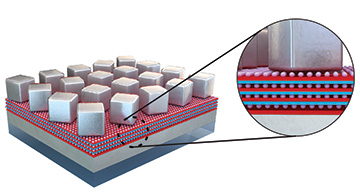
A close-up depiction of the new fiber-free optical WiFi antenna. Silver nanocubes are spaced just a few nanometers above a silver base, with fluorescent dyes sandwiched in between. [Image: Andrew Traverso, Duke University]
The COVID-19 pandemic has brought to light a number of societal inequalities, including the so-called digital divide. During a time of lockdowns and stay-at-home orders, an internet connection serves as a lifeline, allowing people to work from home, attend classes and keep in touch with loved ones. But 3.7 billion people around the world—mostly in poorer countries—have no access to internet.
A possible solution posed by Facebook’s Connectivity Lab is to use solar-powered drones and free-space optical communication to bring internet to remote parts of the world. It enlisted the help of researchers from Duke University, USA, to create a centimeter-scale plasmonic metasurface with record-high efficiency that could enable a large-area, ultrafast detector for such applications (Optica, doi: 10.1364/OPTICA.400731).
Finding the ideal detector
Free-space optical communication offers the potential to send and receive information at a high data rate in the absence of fiber network infrastructures. An ideal detector for this purpose should have a large active area, fast response time and high fidelity. The majority of systems employ semiconductor photodiodes, but their response times scale with detector size, which severely limits their performance.
While photodiodes can be augmented with refractive optics and fluorescent dyes, these methods tend to reduce the detector’s field of view and overall efficiency. Researchers at Facebook’s Connectivity Lab decided to try a different approach involving plasmonic enhancement of luminescent dyes, which had been restricted to small-scale demonstrations at that point.
“The Connectivity Lab at Facebook contacted us and was curious if our previous results on ultrafast and directional spontaneous emission could be applied to tackle challenges facing free-space optical communications,” said Maiken Mikkelsen, an associate professor of electrical and computer engineering and physics at Duke.
Record-high efficiency
Mikkelsen and her colleagues created a 1.2-cm-diameter plasmonic nanogap structure that consists of colloidally synthesized silver nanocubes and a silver film. Sandwiched between the two metal layers is a 7-nm-thick slab of polymer and multiple layers of fluorescent dye to increase efficiency.
Light incident on this structure excites localized surface plasmons—that is, collective oscillations of free electrons in the metal. This causes enhancements in the local electromagnetic field, which changes the environment surrounding the dyes. The dyes then emit light very rapidly after being excited by the incoming light.
Experiments revealed that the large-area metasurface led to a dramatic 910-fold enhancement in the fluorescent intensity and a 133-fold speedup in the spontaneous emission rate. All in all, it successfully converted fast-modulated, wide-incidence-angle light with a 3 dB bandwidth exceeding 14 GHz to a directional source with a record-high efficiency of 30%.
Toward free-space, light-based internet
Such plasmonic effects have never before been demonstrated over such large, centimeter-scale areas, the researchers say, and the results represent a major step in the development of plasmonic systems. As a next step, the researchers would have to piece several plasmonic devices together to cover a 360-degree field of view and incorporate a photodetector.
“Plasmonic structures can be very useful to increase intensity and speed of fluorescence, not just from tiny nanocavities but over large macroscopic, wafer-scale areas, which means the field is maturing,” said Mikkelsen. “It could find applications in free-space optical communications, as both a fast light source and omnidirectional detector, as well as other areas such as biosensing.”
